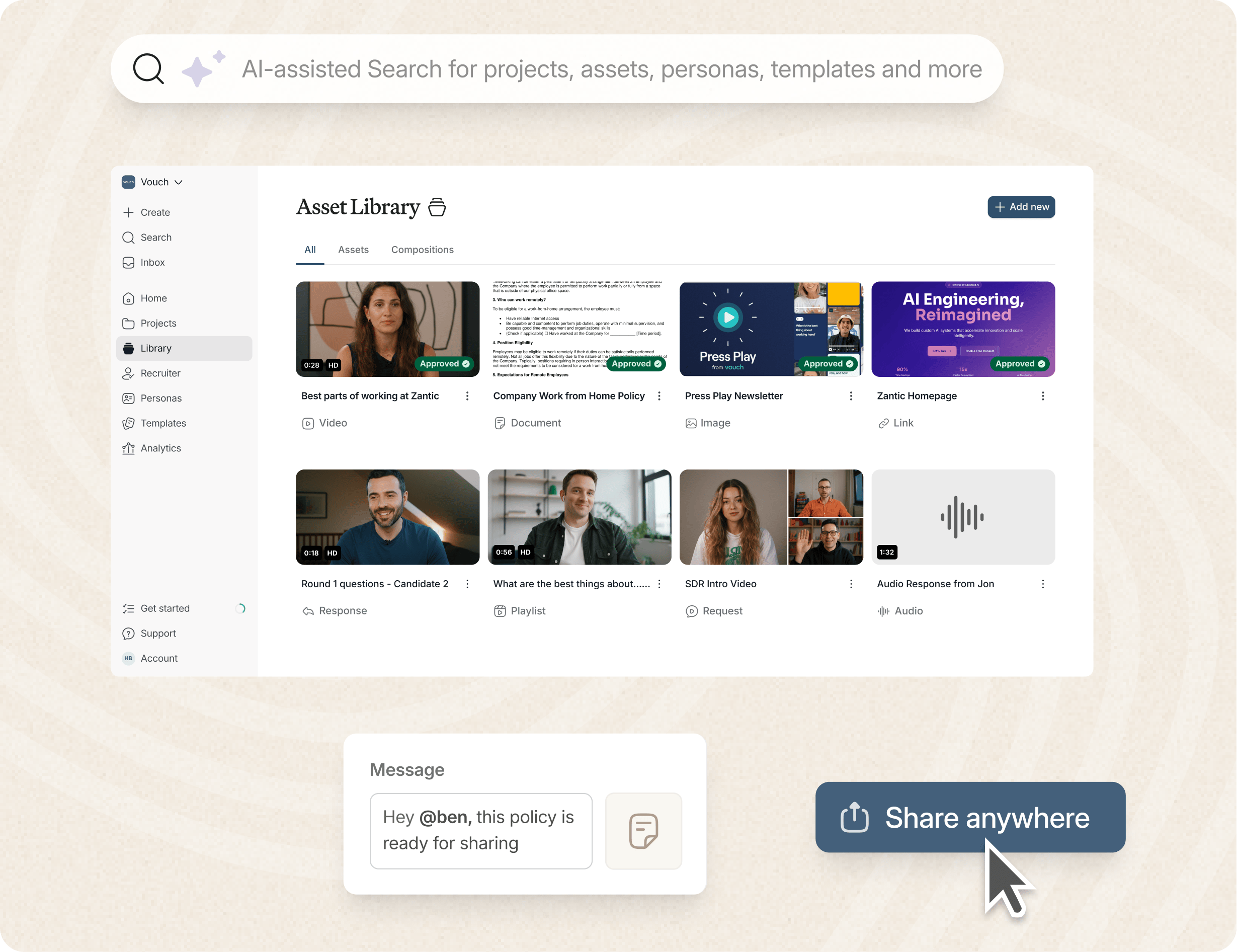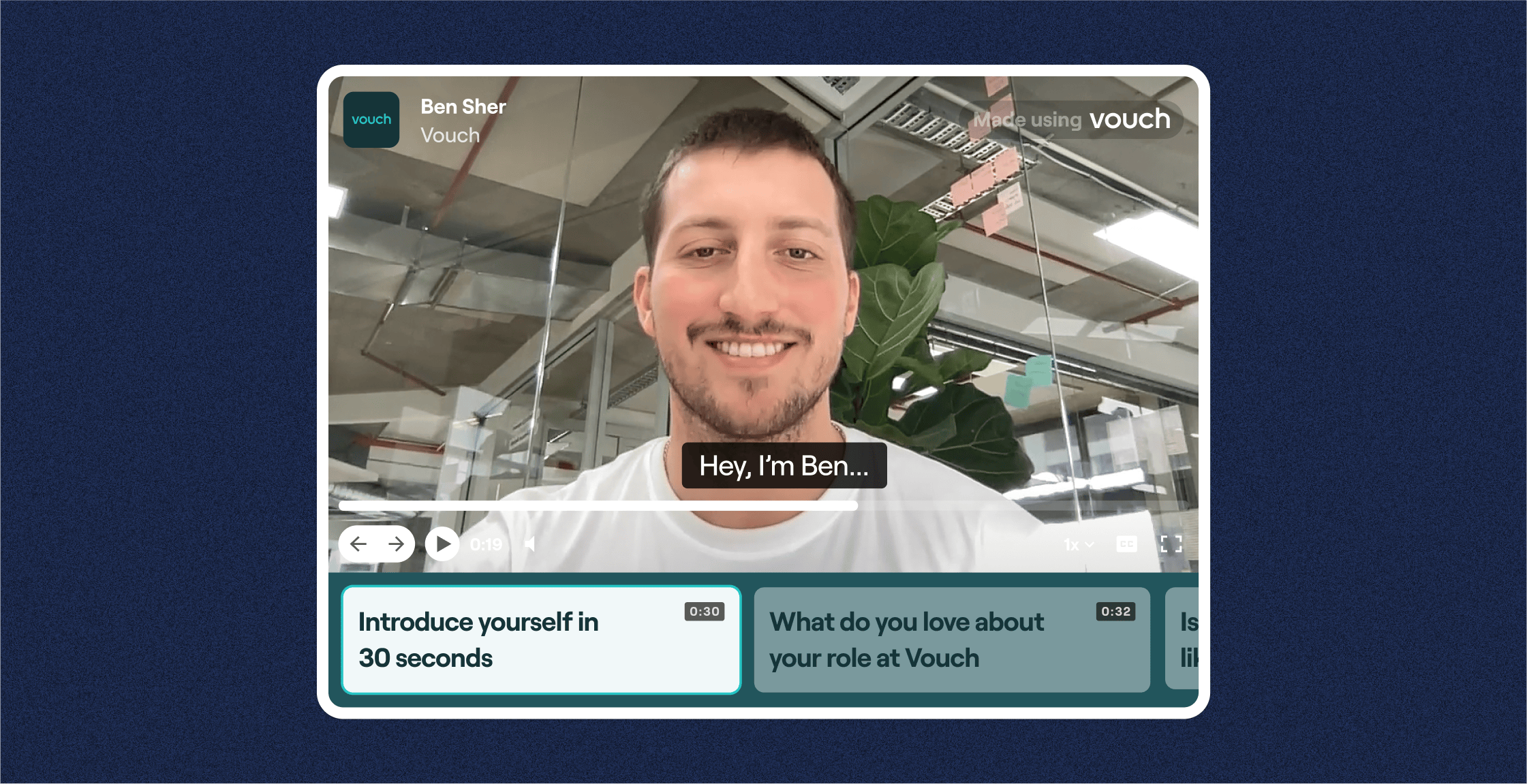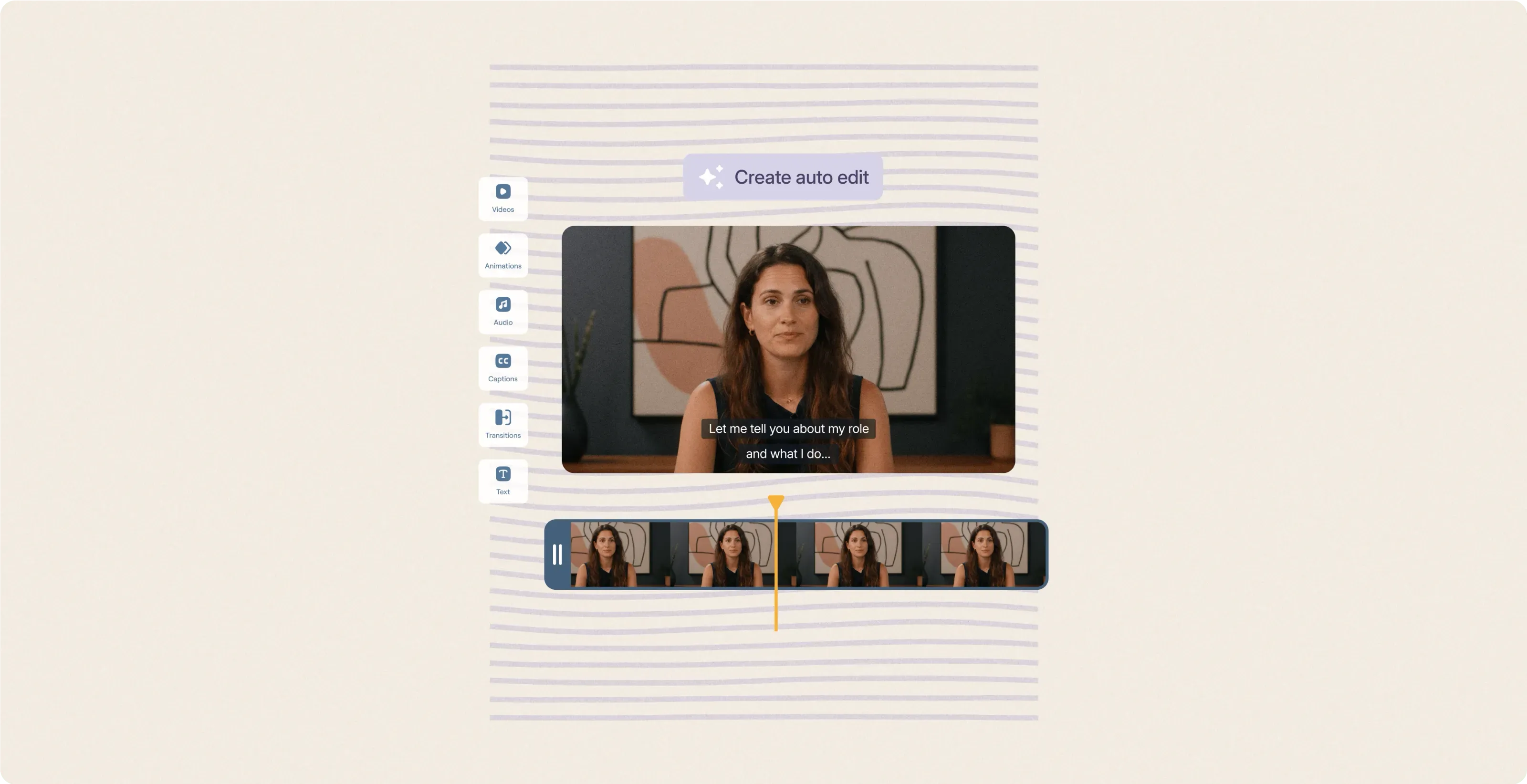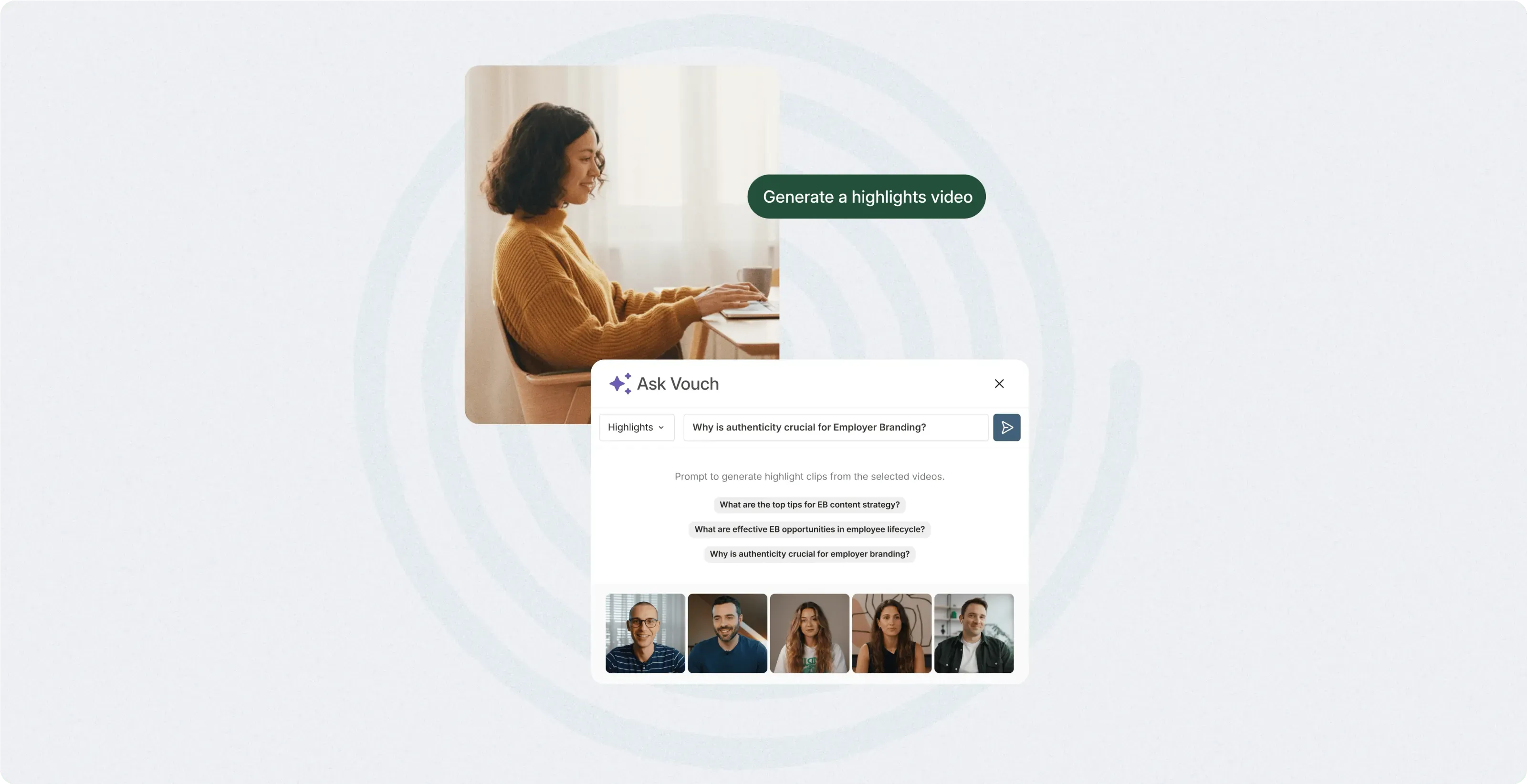Have you been researching employee experience (EX)?
While there are a lot of resources online, improving employee experience is a massive task for any business, as it takes into account every interaction your employees have with your company.
And while there are a lot of resource online, we couldn't find a comprehensive guide, which is vital for any person freshly entering the field, or those who have been working in EX for some time.
Note: Does your company rely on attracting (and retaining) top talent? Vouch is a game-changer for brands like Amazon, Nike, Cisco, Culture Amp, HubSpot, Safety Culture, Stryker, Canva and more. Just click here to get your personal demo and grow your talent pipeline.
Let's dive in.
Key Takeaways
- Employee experience is foundational to business performance and can be a major competitive advantage for your company.
- Investing in positive EX improves employee retention, company culture, and overall business performance.
- Employee experience includes bulding a positive work environment and the use of tools for collaboration and efficiency.
- Tools like Vouch help to make your EX more engaging and effective.
Enhancing employee experience requires a strategic approach, including assessing current employee experience, establishing clear communication channels, and prioritizing professional development and employee feedback.
What Is Employee Experience (EX)?
Employee experience management refers to the holistic approach your company takes to support and enhance the journey of your people.
This includes all touchpoints from recruitment to a team member's exit, and encompasses aspects such as work environment, performance management, and professional development.
The ultimate goal of effective EX management is to increase productivity, job satisfaction and retention - and EX is directly tied to your Employer Brand.
By focusing on your people's needs first, you can have a positive impact on performance and culture, ultimately creating a competitive industry advantage and also attracting more top talent. EX management tools, such as survey tools and next-generation employee experience platforms, can help your company stay on top of emerging trends and respond in real time to improving your overall EX.
EX encompasses all interactions an employee has within your workplace including your company culture, communications, physical environment, incentives and technology. Understanding and improving your EX journey is key to enhanced productivity and staff satisfaction.
What's The Evolution of Employee Experience?
We'll dive into this in this article, but the evolution of EX encompasses shifting focus from basic satisfaction to a more "holistic employee well-being".
It involves adapting to changing workplace dynamics, focusing on diversity and inclusion, embracing technology for enhanced engagement, and recognizing the value of employee feedback - and most of all, their health and happiness. In short, it means caring for your employees more and more as our culture and peoples expectations continue to evolve.
The AI-enabled workspace for talent teams.
- Unified workspace for talent teams
- Accelerate hiring with AI tools
- Auto-generate polished hiring and employer brand content
- Easily repurpose assets across all channel

Why Do You Need To Focus On Your Employee Experience?
When looking at what is employee experience, we need to highlight that focusing on EX is crucial for recruitment, retention, productivity, and for growing your company culture.
A positive experience enhances team satisfaction and loyalty, leading to a more engaged workforce and ultimately better business performance.
Let's break it down a little more:
EX Impact on Recruitment and Retention
To attract and retain top talent, focusing on your "current employee experiences" is paramount.
A positive EX not only enhances recruitment efforts by showcasing your company as an employer of choice, but also aids in reducing turnover rates. Happy staff, who are more likely to stay with your company, are a valuable asset in minimizing turnover and avoiding unnecessary costs. By prioritizing EX, you can create a competitive advantage in the talent market, which is extremely competitive in 2026.
EX Effects on Productivity and Company Culture
Employee experience plays a pivotal role in shaping productivity levels and creating a positive company culture.
When we look at what is employee experience, implementing a well-crafted strategy correlates with enhanced employee engagement, leading to improved business outcomes. When your people feel valued and supported, they tend to be more motivated, resulting in higher engagement levels and ultimately, higher productivity. Furthermore, a positive EX contributes to a strong company culture built on camaraderie, collaboration, and a shared sense of purpose. EX is remarkably powerful.
What Are The Key Components of a Positive Employee Experience?
Key components of a positive EX include:
Your Physical And Remote Workspace Environments
When we look at what is employee experience, creating ana amazing physical workspace environment is vital for enhancing EX and productivity.
By optimizing the layout, lighting, and amenities of your workspaces, you can positively (and quickly) improve your team's engagement and work satisfaction. A well-designed office can also build better collaboration, creativity, and a sense of belonging among team members.
Additionally, incorporating elements that promote wellness, such as ergonomic furniture and green spaces, can contribute to a more positive and vibrant work environment. Investing in the physical workspace reflects a commitment to prioritizing employees' well-being and overall experience. Investing in your people includes investing in their environment.
EX Tools for Collaboration and Efficiency
EX is greatly enhanced by leveraging technological tools for collaboration and efficiency. For example, companies like Nike, Canva, Amazon, Cisco and thousands more use Vouch to improve their EX, and Vouch is a modern EX video tool.
By further integrating AI-powered platforms, teams can streamline communication, project management, and knowledge sharing. Tools like project management software, virtual meeting platforms, and shared document repositories facilitate seamless collaboration regardless of physical location.
Additionally, automation tools can boost efficiency by handling repetitive tasks, allowing your team to focus on high-value work and discover new ways to solve old problems. Investing in these technologies can significantly improve productivity and teamwork within your company, opening up new ways to drive engagement and solve problems.
What Are The Steps to Improving Your Employee Experience?
When we look at what is employee experience, we need to begin by assessing your current EX before implementing improvement strategies.
Clear communication channels and continuous feedback mechanisms are the foundation of creating a culture of growth, from an amazing onboarding experience to when an employee changes roles or even companies.
A solid foundation is crucial before delving into enhancing EX. Before initiating any strategy, ensure you have a clear understanding of your current employee experience landscape. If you are yet to start down this road, "Employee spotlight questions" are a great start, and you can find 25 of the best questions right here: 25 Brilliant Spotlight Questions for Employees
Here are the major EX improvement steps:
Step 1: Assessing Current Employee Experience
Conducting a thorough assessment of your current EX is vital before making any changes. Use survey tools like Vouch to gather quantitative and qualitative data.
Analyze key metrics such as turnover rates, engagement scores, and most of all team feedback. From this feedback, you can dive deeper into aspects like work environment, leadership effectiveness, and career development opportunities. Understand the existing journey to identify pain points and areas for improvement is the vital first step.
Step 2: Establishing Clear Communication Channels
When looking at what is employee experience, clear communication channels are pivotal to creating abetter work environment.
By utilizing tools like Vouch and Slack if suitable for your policies, and also implementing regular check-in meetings, you can ensure that information flows seamlessly across all levels. This open dialogue enhances engagement and reduces misunderstandings. Effective communication channels also provide a platform for employees to voice concerns, share ideas, and receive feedback promptly, creating a collaborative and inclusive workplace culture.
By prioritizing transparent communication, you can quickly strengthen relationships and boost overall employee satisfaction.
Step 3: Developing Continuous Feedback Mechanisms
When we look at what is employee experience, we can't overstate the importance of developing continuous feedback mechanisms for improving yoru EX.
Gathering real-time insights into your employee needs and concerns is everything.
Video surveys through tools like Vouch provide short, personal tools that capture feedback, no matter where your team are, offering valuable data for improvement. Seeking input from employees helps address issues promptly, and implementing a tool like Vouch shows that your organization values your employees' opinions, enhancing engagement and productivity.
By listening continuously, you can work on ongoing improvements and your overall employee experience.
Step 4: Implementing Employee Development Programs
Implementing employee development programs is crucial for enhancing the employee experience.
These programs offer learning opportunities, career growth, skill development, and are also vital for attracting top talent.
Such EX programs can include training workshops, mentoring, leadership initiatives, and tuition reimbursement. By investing in employee growth, your organizations can demonstrate commitment and improve your employee's skills at the same time. It's a win-win.
Your employee development programs contribute to a positive experience and a culture of excellence, which are the foundations of your EX.
How Do You Measure The Impact of Employee Experience?
Measuring the impact of your EX invites is vital for your company to gauge the strategies that work best, and which strategies are not helping.
Key performance indicators (KPIs) like engagement levels, turnover rates, productivity, customer satisfaction, and financial performance can assess success and business impact. As mentioned, EX surveys also play a crucial role in gathering feedback to track satisfaction, identify areas for improvement, and monitor changes in sentiment over time.
Analyzing this data helps you drive overall business success. Here are the key metrics to track:
Key Metrics and KPIs to Track
Tracking KPIs is crucial for measuring the impact of your EX initiatives.
Key metrics to monitor include:
- Employee engagement: Measures emotional connection and commitment to work, impacting productivity and profitability.
- Employee turnover: Indicates retention levels, with high rates signaling issues.
- Productivity: Assessing effectiveness of employee experience initiatives.
- Customer satisfaction: Directly affected by employee engagement.
- Financial performance: Reflects impact of employee experience on profits and revenue.
By tracking these metrics through surveys and data analysis, your can work on the EX areas that drive better outcomes.
Employee Experience Survey Best Practices
At Vouch, companies like Canva, Nike, Cisco, Amazon and more use our video tool to survey their employees, for good reason.
Video, unlike text based surveys, lets you see your employees and read between the lines, being able to see their body language, facial expressions and more. You can also share these video with your HR and leadership team if you need to.
- Designing surveys with clear objectives: Clearly define the purpose of the survey and the specific areas of the employee experience you want to measure. This will ensure that the survey questions are focused and relevant.
- Ensuring anonymity and confidentiality: Employees should feel comfortable providing honest feedback without fear of repercussions. Every surveys should help create a safe space for employees to share their opinions and experiences.
- Regularly collecting and analyzing data: Conducting surveys at regular intervals allows you to track changes in employee sentiment over time. Analyzing survey data helps identify trends, areas for improvement, and opportunities for enhancing your EX.
- Acting on survey feedback: Survey results should not be ignored. your company should take actionable steps based on the feedback received to address any issues and improve the employee experience. Communicating the actions taken to address feedback also demonstrates that your organization values your employee input.
Employee experience surveys provide valuable insights into the employee experience and can guide your company in making data-driven decisions to enhance employee satisfaction, engagement, and overall business performance.
What Are The Challenges Of EX?
Addressing EX challenges is vital for a positive work environment and employee satisfaction.
Common hurdles include remote work, well-being, and managing diversity.
Remote work has surged post-COVID-19, requiring your company to ensure remote employees feel connected through communication and virtual activities.
Let's dive a little deeper:
How To Navigate Remote and Hybrid Work Dynamics?
Remote and hybrid work are common in today's workplace. Providing the right tools, resources, and clear guidelines is key for EX.
For remote workers, offer reliable tech, secure communication, and clear expectations.
In a hybrid setup, establish flexible schedules, safe workspaces, and promote collaboration.
Trust, clear communication, and flexibility are essential for positive work environments in remote and hybrid setups. Embracing these dynamics enhances the employee experience and business outcomes.
How To Mitigate Burnout While Improving Well-being?
Mitigating burnout while improving employee well-being are critical for ensuring a positive EX at all times.
Burnout can have severe consequences on employees' mental and physical health, as well as their overall job satisfaction.
To mitigate burnout, you need to promote work-life balance and providing resources and support for employees to manage their workload effectively. Encouraging breaks, setting realistic expectations, and offering flexible work arrangements can help employees avoid burnout and maintain their well-being.
Wellness programs are another effective way to improve employee well-being.
These programs can include initiatives such as mental health resources, fitness programs, stress management workshops, and employee assistance programs. By investing in employee well-being, your company can demonstrate its commitment to the health and happiness of their employees, resulting in a positive employee experience and improved business outcomes.
How To Leverage Technology to Enhance EX?
When we look at what is employee experience, leveraging technology is essential for enhancing employee experience in today's digital age.
Technology can streamline processes, improve communication, and empower employees to be more engaged and productive.
Innovative tools for engagement and productivity, such as collaboration platforms, project management software, and virtual meeting tools, can enhance communication and collaboration among team members. These tools facilitate seamless collaboration, regardless of geographical location, and help employees stay connected and engaged.
Here are some amazing EX tools, used by companies of all shapes and sizes across the world:
- Collaboration platforms: Tools like Vouch, Microsoft Teams, Slack, and Google Workspace facilitate real-time communication, file sharing, and collaboration among team members. They streamline workflows and enable remote teams to work together effectively.
- Project management software: Tools like Asana, Trello, and Monday.com help teams organize and track projects, assign tasks, and manage timelines. These tools improve productivity, ensure accountability, and enhance team collaboration.
- Virtual meeting tools: Platforms like Microsoft Teams and Google Meet enable remote teams to conduct virtual meetings, video conferences, and screen sharing. These tools facilitate face-to-face communication and collaboration, regardless of geographical locations.
- Employee recognition platforms: Tools like Bonusly, Kazoo, and Achievers provide a platform for peer-to-peer recognition, rewards, and feedback. They create a culture of appreciation and recognition, boosting employee engagement and morale.
By leveraging these innovative tools, you can create a digital work environment that enhances employee engagement, productivity, and collaboration. These tools contribute to a positive employee experience and drive better business outcomes.
Should You Integrate AI for Personalized Employee Growth Paths?
The short answer is yes, if you have the resources to support these tools. To see the kind of AI tools we are referring too, please see this Forbes article.
Integrating AI into EX can help provide personalized employee growth paths and career development opportunities and these AI-driven tools can analyze employee data, identify skill gaps, and recommend personalized learning resources.
AI-powered career development platforms are perfect for suggesting relevant training courses, certifications, and learning opportunities based on an employee's current skill set and career aspirations. In conjunction with Vouch, these platforms can also provide real-time feedback and performance insights, enabling employees to track their progress and align their development goals with organizational objectives.
When we look at what is employee experience, in 2026, leveraging AI is a huge focus for many organizations, to create personalized learning experiences that cater to individual employee needs and preferences.
Case Studies: Companies Excelling in Employee Experience
Case studies provide valuable insights into companies that have excelled in employee experience. By studying these success stories, your company can learn from industry leaders and adopt best practices to enhance their own employee experience initiatives.
Industry leaders such as Google, Microsoft, and Salesforce are known for their exceptional employee experiences.
They prioritize employee well-being, offer extensive professional development opportunities, and build a culture of innovation and collaboration.
These companies understand that a positive employee experience is a competitive advantage. By investing in their employees' growth and well-being, they attract and retain top talent, drive innovation, and achieve better business outcomes. Their success serves as a testament to the power of a great employee experience.
Lessons Learned from Industry Leaders
Industry leaders offer valuable lessons for enhancing employee experience initiatives:
- Prioritize well-being: Google and Salesforce prioritize well-being through wellness programs and flexible work arrangements, creating a positive work environment.
- Provide professional development: Microsoft and Salesforce focus on employee growth with training programs and mentorship opportunities, contributing to long-term success.
- Encourage innovation and collaboration: Google and Microsoft promote creativity and collaboration, enhancing engagement and a sense of belonging.
By adopting these practices, organizations can attract top talent, drive innovation, and improve business performance.
Adapting Strategies for Your Organisation
Adapting employee experience strategies to your needs and culture is crucial for success. Tailoring strategies to align with your goals and values is key.
Start by assessing current employee experience, identifying areas for improvement, and understanding their needs through surveys and feedback. Develop a targeted strategy focusing on key areas.
Involve employees by seeking their input for a strategy aligned with their preferences. Regularly evaluate initiatives and make adjustments as needed for continuous improvement.
By tailoring strategies to fit your organization, you can create a positive employee experience driving better outcomes.
FAQs
What is the definition of workplace experience?
When we look at what is employee experience, we are refering to the overall journey a worker goes through in your company. Workplace experience is the sum of all interactions, environments, and operations within a workplace that shape an employee's perceptions. It encompasses physical space, culture, technology, and support systems provided by the employer.
How can companies improve employee experience within the workplace?
Companies can improve employee experience by creating a positive work environment. This includes creating a supportive company culture, providing opportunities for professional development, offering competitive benefits and compensation, and creating a healthy work-life balance. By listening to employee feedback and addressing their needs, your company can continuously improve the employee experience and increase employee satisfaction.
What are some employee experience best practices?
Some employee experience best practices include providing clear communication and feedback, recognizing and rewarding employee achievements, promoting a diverse and inclusive workplace, offering opportunities for career growth, and ensuring a healthy work-life balance. By implementing these best practices, your company can create a positive employee experience and increase employee retention.
What is employee experience and why is it important?
When we look at what is employee experience, we need to consider everything a worker learns, does, sees, and feels at each stage of the employee lifecycle. It is important because a positive employee experience leads to increased employee satisfaction, productivity, and retention. It also directly impacts business outcomes, such as profitability and customer satisfaction.
How Does Employee Experience Differ From Employee Engagement?
Employee experience refers to the overall experience a worker has at every stage of the employee lifecycle, including the work environment, company culture, and personal development opportunities. Employee engagement, on the other hand, focuses on the emotional connection and level of commitment an employee has towards their work and the organization.
What Are the First Steps in Creating an Employee Experience Strategy?
When we look at what is employee experience, the first steps in creating a strategy that involves assessing the current employee experience, identifying areas for improvement, and setting goals and objectives. Business leaders should take the lead in championing the employee experience and involving employees in shaping the strategy. It is important to establish a starting point and continuously measure progress.
What impact does employee experience have on overall company performance?
Employee experience has a direct impact on overall company performance. A positive employee experience leads to increased productivity, employee satisfaction, and retention. It also improves customer satisfaction and loyalty, which in turn drives business outcomes such as revenue and profitability. Investing in employee experience is key to achieving success in today's competitive business landscape.
Conclusion
In conclusion, prioritizing your employee experience (EX) is crucial for long-term success.
By focusing on creating a positive work environment, implementing effective communication channels, and offering continuous feedback and development opportunities, companies can boost recruitment, retention, productivity, and company culture.
It's also essential to measure the impact of employee experience through key metrics and surveys, and continually strive to address challenges like remote work dynamics and burnout. Leveraging modern EX tools like Vouch can also help significantly for improving your engagement and personalization.
Embracing a holistic approach to EX, and at te end of te day, EX is all about putting your employees first, just like you do with your best customers.
Like to try Vouch?
Loved by companies like Canva, Nike, Cisco, HubSpot, Amazon, and more, tools like Vouch make leveraging video in your business remarkably easy.
Be sure to book a Vouch demo today and chat with an EX expert.
You might also like

Elevate Your Brand Today With Vouch
Discover how Vouch can accelerate talent acquisition while helping you stay on-brand.






